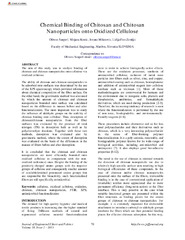Chemical Binding of Chitosan and Chitosan Nanoparticles onto Oxidized Cellulose
Чланак у часопису (Објављена верзија)
Метаподаци
Приказ свих података о документуАпстракт
The aim of this study was to analyze binding of chitosan and chitosan nanoparticles onto cellulose via oxidized cellulose. The ability of chitosan and chitosan nanoparticles to be adsorbed onto surfaces was determined by the use of the XPS spectroscopy which provided information about chemical composition of the fiber surface. On the other hand, the gravimetric method was also used by which the amount of chitosan and chitosan nanoparticles bounded onto surface was calculated based on the difference in masses before and after functionalization. The most important was to study the influence of aldehyde groups on the stability of chitosan binding onto cellulose. Thus, desorption of chitosan/chitosan nanoparticles from the fiber surfaces was evaluated by the presence of total nitrogen (TN) in desorption bath as well as by polyelectrolyte titrations. Together with these two methods, desorption was evaluated also by gravimetric method, where the extent of desorption was evaluated on the basi...s of the differences in the masses of fibers before and after desorption. It is concluded that the chitosan and chitosan nanoparticles are more efficiently bounded onto oxidized cellulose in comparison with the non-oxidized (reference) ones. Despite the binding of the positively-charged amino groups with the negative groups of cellulose and consequently smaller amount of available/residual protonated amino groups that are responsible for bioactivity, such functionalized fibers are still specifically antimicrobial.
Кључне речи:
cellulose / oxidized cellulose / oxidation / chitosan / chitosan nanoparticles / FTIR / XPS / antimicrobial functionalizationИзвор:
Journal of Engineered Fibers and Fabrics, 2015, 10, 2, 70-77Издавач:
- Sage Publications Ltd, London
Колекције
Институција/група
Tehnološko-metalurški fakultetTY - JOUR AU - Sauperl, Olivera AU - Kostić, Mirjana AU - Milanović, Jovana AU - Zemljić, Lidija F. PY - 2015 UR - http://TechnoRep.tmf.bg.ac.rs/handle/123456789/3152 AB - The aim of this study was to analyze binding of chitosan and chitosan nanoparticles onto cellulose via oxidized cellulose. The ability of chitosan and chitosan nanoparticles to be adsorbed onto surfaces was determined by the use of the XPS spectroscopy which provided information about chemical composition of the fiber surface. On the other hand, the gravimetric method was also used by which the amount of chitosan and chitosan nanoparticles bounded onto surface was calculated based on the difference in masses before and after functionalization. The most important was to study the influence of aldehyde groups on the stability of chitosan binding onto cellulose. Thus, desorption of chitosan/chitosan nanoparticles from the fiber surfaces was evaluated by the presence of total nitrogen (TN) in desorption bath as well as by polyelectrolyte titrations. Together with these two methods, desorption was evaluated also by gravimetric method, where the extent of desorption was evaluated on the basis of the differences in the masses of fibers before and after desorption. It is concluded that the chitosan and chitosan nanoparticles are more efficiently bounded onto oxidized cellulose in comparison with the non-oxidized (reference) ones. Despite the binding of the positively-charged amino groups with the negative groups of cellulose and consequently smaller amount of available/residual protonated amino groups that are responsible for bioactivity, such functionalized fibers are still specifically antimicrobial. PB - Sage Publications Ltd, London T2 - Journal of Engineered Fibers and Fabrics T1 - Chemical Binding of Chitosan and Chitosan Nanoparticles onto Oxidized Cellulose EP - 77 IS - 2 SP - 70 VL - 10 UR - https://hdl.handle.net/21.15107/rcub_technorep_3152 ER -
@article{
author = "Sauperl, Olivera and Kostić, Mirjana and Milanović, Jovana and Zemljić, Lidija F.",
year = "2015",
abstract = "The aim of this study was to analyze binding of chitosan and chitosan nanoparticles onto cellulose via oxidized cellulose. The ability of chitosan and chitosan nanoparticles to be adsorbed onto surfaces was determined by the use of the XPS spectroscopy which provided information about chemical composition of the fiber surface. On the other hand, the gravimetric method was also used by which the amount of chitosan and chitosan nanoparticles bounded onto surface was calculated based on the difference in masses before and after functionalization. The most important was to study the influence of aldehyde groups on the stability of chitosan binding onto cellulose. Thus, desorption of chitosan/chitosan nanoparticles from the fiber surfaces was evaluated by the presence of total nitrogen (TN) in desorption bath as well as by polyelectrolyte titrations. Together with these two methods, desorption was evaluated also by gravimetric method, where the extent of desorption was evaluated on the basis of the differences in the masses of fibers before and after desorption. It is concluded that the chitosan and chitosan nanoparticles are more efficiently bounded onto oxidized cellulose in comparison with the non-oxidized (reference) ones. Despite the binding of the positively-charged amino groups with the negative groups of cellulose and consequently smaller amount of available/residual protonated amino groups that are responsible for bioactivity, such functionalized fibers are still specifically antimicrobial.",
publisher = "Sage Publications Ltd, London",
journal = "Journal of Engineered Fibers and Fabrics",
title = "Chemical Binding of Chitosan and Chitosan Nanoparticles onto Oxidized Cellulose",
pages = "77-70",
number = "2",
volume = "10",
url = "https://hdl.handle.net/21.15107/rcub_technorep_3152"
}
Sauperl, O., Kostić, M., Milanović, J.,& Zemljić, L. F.. (2015). Chemical Binding of Chitosan and Chitosan Nanoparticles onto Oxidized Cellulose. in Journal of Engineered Fibers and Fabrics Sage Publications Ltd, London., 10(2), 70-77. https://hdl.handle.net/21.15107/rcub_technorep_3152
Sauperl O, Kostić M, Milanović J, Zemljić LF. Chemical Binding of Chitosan and Chitosan Nanoparticles onto Oxidized Cellulose. in Journal of Engineered Fibers and Fabrics. 2015;10(2):70-77. https://hdl.handle.net/21.15107/rcub_technorep_3152 .
Sauperl, Olivera, Kostić, Mirjana, Milanović, Jovana, Zemljić, Lidija F., "Chemical Binding of Chitosan and Chitosan Nanoparticles onto Oxidized Cellulose" in Journal of Engineered Fibers and Fabrics, 10, no. 2 (2015):70-77, https://hdl.handle.net/21.15107/rcub_technorep_3152 .



